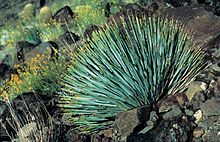| Grand Canyon Quixote plant | |
|---|---|

| |
| Scientific classification | |
| Kingdom: | Plantae |
| Clade: | Tracheophytes |
| Clade: | Angiosperms |
| Clade: | Monocots |
| Order: | Asparagales |
| Family: | Asparagaceae |
| Subfamily: | Agavoideae |
| Genus: | Hesperoyucca |
| Species: | H. newberryi |
| Binomial name | |
| Hesperoyucca newberryi (McKelvey) Clary | |
| Synonyms | |
| |
Hesperoyucca newberryi, commonly known as the Grand Canyon Quixote plant or Newberry's yucca, is a plant species endemic to Arizona. It is found only in Mohave and Coconino Counties, on the walls of canyons near the Colorado River.
Hesperoyucca newberryi is a perennial forming a rosette. It is semelparous (flowering once then dying). Leaves are narrow, up to 60 cm (24 in) long but usually less than 3 cm (1.2 in) across. Flowering stalks are up to 160 cm (63 in) tall, bearing cream-colored flowers. The fruit is a dry, egg-shaped capsule about 4 cm (1.6 in) long.
References
- Tropicos
- ^ Flora of North America v 26 p 441, Hesperoyucca newberryi
- BONAP (Biota of North America Program) floristic synthesis, 2013, Hesperoyucca newberryi
- Clary, Karen Husum. 2001. The genus Hesperoyucca (Agavaceae) in the western United States and Mexico: New nomenclatural combinations. Sida 19(4): 839–847.
- McKelvey, Susan Delano. 1947. Yuccas of the Southwestern United States 2: 49–52, map 1.
- Hochstätter, F. 2000. Succulenta (Netherlands) 79:39.
- United States Department of Agriculture, National Forest Service database, Hesperocallis whipplei, H. newberryi
| Taxon identifiers | |
|---|---|
| Hesperoyucca newberryi |
|
| Yucca newberryi | |